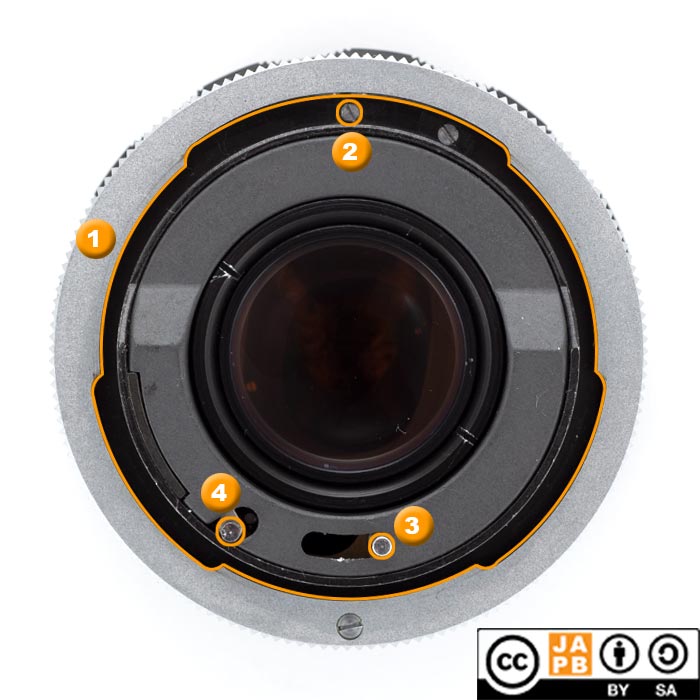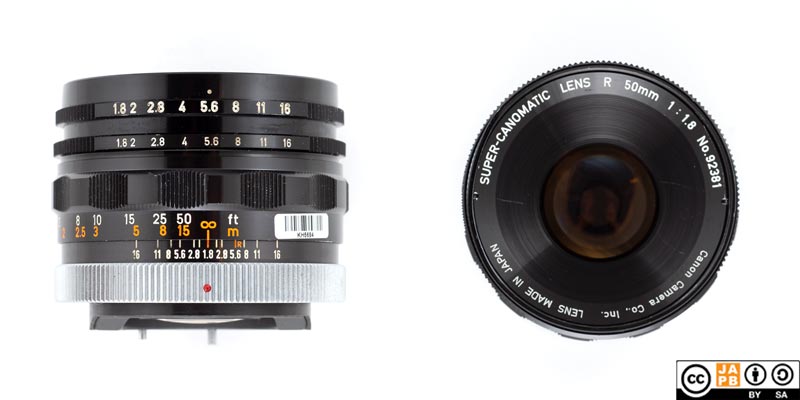Pekka Buttler (Updated 5/2025)
Introduction: a naming issue
There is and has always been some confusion about the naming of this lens mount. The various names and explanations are:
• Canonflex: Because the series of cameras that these lenses were designed for were all named Canonflex: (Canonflex, Canonflex RP, Canonflex R2000 and Canonflex RM). Also, many lens mounts are named in accordance with the first camera that uses the mount (Nikon F, Olympus OM, Konica AR, Minolta SR, etc.)
• Canomatic: Because all the lenses for this mount proudly sport the name on the lens’ name rings. Also, because this name is unique to this line of interchangeable lenses it is a good identifier.
• R: Because Canon itself1 refers to the lens mount as the Canon R mount, and because all other Canon lens mounts are short abbreviations (e.g. FL, FD, EF, etc.) instead of long names.
On the other hand, since Canon named its mirrorless interchangeable system mount the RF mount and some people have started calling it the Canon R mount (because all the cameras are named Canon R[something]), there is some risk of confusion in speaking of the R mount.
Canon R mount specifications and identification
Mount type: Breech-lock (locking ring on lens)
Flange focal distance: 42,00 mm
Film format: 36mm x 24mm (‘Full frame’)
Mount communication:
• aperture stop-down lever (‘triggering’)
• aperture automation cocking lever (‘arming’)

Key characteristics of the mount of Canon R (Canomatic) lenses:
[1] Breech lock locking ring, rotates approximately 90 degrees (when not connected to a camera).
[2] Alignment pin.
[3] Aperture arming lever.
[4] Aperture stop-down triggering lever.
Basic Information on the Canon R mount:
The closing years of the 1950s were a busy and auspicious time for the Japanese Camera industry. Asahi Optical introduced the Pentax and Tokyo Kogaku introduced the Topcon R in 1957, Minolta introduced the SR-2 (and the Minolta SR mount) in 1958, while Nippon Kogaku introduced the Nikon F (and Nikon F mount) in 1959 (and these are just the highlights). It is hence understandable that Canon’s launch of its first interchangeable lens SLR – the Canonflex – in 1959 did not make particularly big waves.
To say it bluntly, while the Canonflex (and its successors the Canonflex RP, Canonflex R2000 and Canonflex RM) were by no means bad cameras, they were thoroughly overshadowed by their competition. Also, in some respects Canon had not been especially prescient in the design of the Canonflex and its lens mount, particularly with regards to aperture automation and wide-open metering.
Canon (Canomatic) R lenses used a ‘different’ approach to auto aperture, in that while you could set the lens to a specific aperture (say, f/5.6) that you wanted your picture taken at, and the camera would stop down the lens only just before exposing the film, the lens would then remain at that aperture until the lens was ‘armed’ or ‘cocked’ again. This meant that Canon R lenses used a set of two levers in the lens mount – one for ‘arming’ the auto aperture function (indicated by ‘3’ in the picture below), and another for ‘triggering’ it (‘4).
Simultaneously, Canon R lenses sported two aperture rings (which kind-of makes them look like classic preset lenses), so that one ring (closer to the front of lens) would be used for setting which aperture the auto aperture should stop down to, and the other (rearward) allowed direct manual control of the aperture.

As a result, Canon in 1964 replaced the Canonflex lineup with a new series of cameras (where the ‘flex’ was replaced simply with the letter ‘F’) and a redesigned lens mount (the Canon FL mount). While the Canon R and Canon FL (as well as FD and FDn) mounts use the same physical connection between lens and camera, and while Canon FL, FD and FDn are largely compatible, the same could not be said going from Canon R to FL. Sure, you could mount most Canon R lenses on the Canon FL body, but because the levers did not line up, you were limited to manual aperture…
Adapting Canon R lenses
Firstly, Canomatic R lenses can only be used natively and with all intended features on Original Canon R (Canonflex) bodies. While these are far less numerous than the subsequent FL and FD bodies, the original Canonflex’ were generally well-built and functioning copies are not impossible to come by.
If you’re using a mirrorless camera, Canon R lenses can be adapted using a Canon FD–>[your system] adapter. However, adapting Canon R lenses using a vanilla Canon FD adapter will – with many Canon R lenses – pose issues. The reason for this is that Canon R lenses (just as with some Canon FL lenses) protrude so far into the mount, that the placing of the aperture engage pin in most adapters does not allow the lens to be mounted. The solution for this problem is rather simple: buy another Canon FD-> [your system] adapter and remove the pin. Thereafter you will be able to use your Canon R lens on a mirrorless camera without issues. There is a JAPB article that discusses this issue in a bit more detail here.
Should you feel like trying your Canon R lens on a dSLR, you can expect some trouble. First – due to the short flange focal distance – you will have to either forgo being able to focus on anything close to infinity, or get an adapter with corrective optics. Next, you will have to remove the aperture engage pin from the adapter to be able to fit your Canon R lens. Finally – depending on the Canon R lens and the design of the particular adapter with optics – it may be that the rear of the Canon R lens will collide with the adapter optics, hence making it impossible to mount your lens.
Read more:
• Flynn Marr on the Canonflex series of cameras.
• Flynn Marr on the Canon(matic) R series of lenses.
• Canon R lenses on the Canon Camera Museum.
Footnotes:
- See e.g. the Canon Camera museum. ↩︎